Description
James Sidney Edouard, Baron Ensor (13 April 1860 – 19 November 1949[1]) was a Belgian painter and printmaker, an important influence on expressionism and surrealism who lived in Ostend for almost his entire life.
From 1877 to 1880, he attended the Académie Royale des Beaux-Arts in Brussels, where one of his fellow students was Fernand Khnopff. Ensor first exhibited his work in 1881. From 1880 until 1917, he had his studio in the attic of his parents’ house.
During the late 19th century much of his work was rejected as scandalous, particularly his painting Christ’s Entry Into Brussels in 1889 (1888–89). The Belgium art critic Octave Maus famously summed up the response from contemporaneous art critics to Ensor’s innovative (and often scathingly political) work: “Ensor is the leader of a clan. Ensor is the limelight. Ensor sums up and concentrates certain principles which are considered to be anarchistic. In short, Ensor is a dangerous person who has great changes. … He is consequently marked for blows. It is at him that all the harquebuses are aimed. It is on his head that are dumped the most aromatic containers of the so-called serious critics.” Some of Ensor’s contemporaneous work reveals his defiant response to this criticism. For example, the 1887 etching “Le Pisseur” depicts the artist urinating on a grafitied wall declaring (in the voice of an art critic) “Ensor est un fou” or “Ensor is a Madman.”
But his paintings continued to be exhibited, and he gradually won acceptance and acclaim. In 1895 his painting The Lamp Boy (1880) was acquired by the Royal Museums of Fine Arts of Belgium in Brussels, and he had his first solo exhibition in Brussels. By 1920 he was the subject of major exhibitions; in 1929 he was named a Baron by King Albert, and was the subject of the Belgian composer Flor Alpaerts’s James Ensor Suite; and in 1933 he was awarded the band of the Légion d’honneur. Alfred H. Barr, Jr., the founding director of the Museum of Modern Art in New York, after considering Ensor’s 1887 painting Tribulations of Saint Anthony (now in MoMA’s collection), declared Ensor the boldest painter working at that time.
Even in the first decade of the 20th century, however, his production of new works was diminishing, and he increasingly concentrated on music—although he had no musical training, he was a gifted improviser on the harmonium, and spent much time performing for visitors. Against the advice of friends, he remained in Ostend during World War II despite the risk of bombardment. In his old age he was an honored figure among Belgians, and his daily walk made him a familiar sight in Ostend. He died there after a short illness, on 19 November 1949.
The reverse side of the geocoin represents masks that are shown in the “Ensor House”. Here the painter’s uncle and the aunt sold shells, toys, postcards and especially masks. Those masks are still behind glass in the original shop cabinets. As you know, masks are everywhere in the entire oeuvre of the artist. It ‘s with his uncle and aunt that the young James has gained that inspiration. After their death, the house came into his possession in 1917. He left the store room unchanged and inhabited the house until his death in 1949.
The extra thick coin measures 70 by 45 MM in size .
The front and back are a 3D cast zinc alloy with all 3 sides polished and with antique tin plating.
The coin comes in a black velvet pouch!
The antique tin plating is a extra limited edition – 50.
The tracking codes have the BE prefix.
This item has a unique icon, and is trackable at geocaching.com.

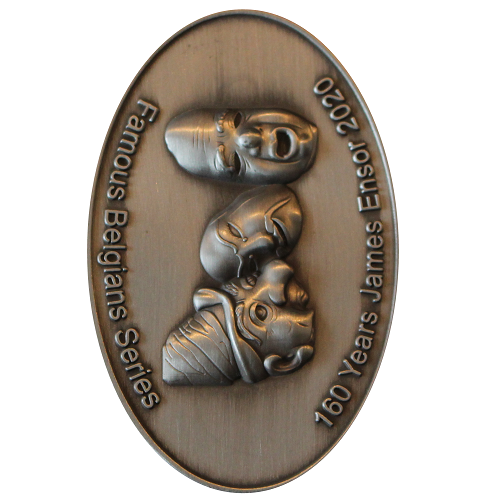

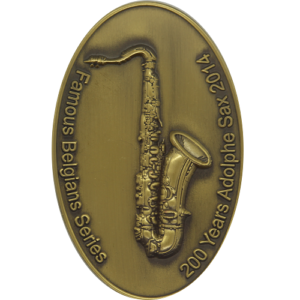
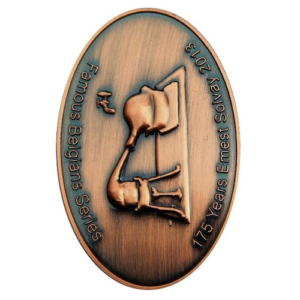
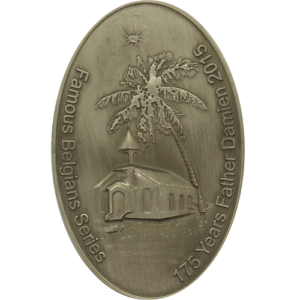
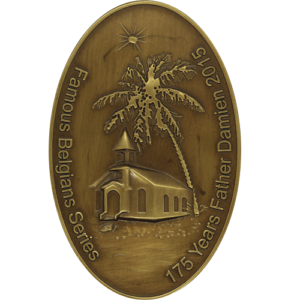
Reviews
There are no reviews yet.